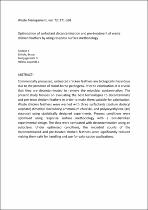 ResearchSpace
ResearchSpace
Optimisation of surfactant decontamination and pre-treatment of waste chicken feathers by using response surface methodology
JavaScript is disabled for your browser. Some features of this site may not work without it.
- ResearchSpace
- →
- Research Publications/Outputs
- →
- Journal Articles
- →
- View Item
| dc.contributor.author |
Tesfaye, T

|
|
| dc.contributor.author |
Sithole, Bishop B

|
|
| dc.contributor.author |
Ramjugernath, D

|
|
| dc.contributor.author |
Ndlela, Luyanda L

|
|
| dc.date.accessioned | 2018-06-25T12:36:36Z | |
| dc.date.available | 2018-06-25T12:36:36Z | |
| dc.date.issued | 2018-02 | |
| dc.identifier.citation | Tesfaye, T. et al. 2018. Optimisation of surfactant decontamination and pre-treatment of waste chicken feathers by using response surface methodology. Waste Management, vol. 72: 371-388 | en_US |
| dc.identifier.issn | 0956-053X | |
| dc.identifier.uri | https://doi.org/10.1016/j.wasman.2017.11.013 | |
| dc.identifier.uri | https://www.sciencedirect.com/science/article/pii/S0956053X17308127 | |
| dc.identifier.uri | http://hdl.handle.net/10204/10283 | |
| dc.description | Copyright: 2018 Elsevier. Due to copyright restrictions, the attached PDF file only contains the abstract of the full text item. For access to the full text item, please consult the publisher's website. | en_US |
| dc.description.abstract | Commercially processed, untreated chicken feathers are biologically hazardous due to the presence of blood-borne pathogens. Prior to valorisation, it is crucial that they are decontaminated to remove the microbial contamination. The present study focuses on evaluating the best technologies to decontaminate and pre-treat chicken feathers in order to make them suitable for valorisation. Waste chicken feathers were washed with three surfactants (sodium dodecyl sulphate) dimethyl dioctadecyl ammonium chloride, and polyoxyethylene (40) stearate) using statistically designed experiments. Process conditions were optimised using response surface methodology with a Box-Behnken experimental design. The data were compared with decontamination using an autoclave. Under optimised conditions, the microbial counts of the decontaminated and pre-treated chicken feathers were significantly reduced making them safe for handling and use for valorisation applications. | en_US |
| dc.language.iso | en | en_US |
| dc.publisher | Elsevier | en_US |
| dc.relation.ispartofseries | Worklist;20005 | |
| dc.subject | Chicken feathers | en_US |
| dc.subject | Grease content | en_US |
| dc.subject | Microbial count | en_US |
| dc.subject | Surfactant | en_US |
| dc.subject | Whiteness | en_US |
| dc.title | Optimisation of surfactant decontamination and pre-treatment of waste chicken feathers by using response surface methodology | en_US |
| dc.type | Article | en_US |
| dc.identifier.apacitation | Tesfaye, T., Sithole, B. B., Ramjugernath, D., & Ndlela, L. L. (2018). Optimisation of surfactant decontamination and pre-treatment of waste chicken feathers by using response surface methodology. http://hdl.handle.net/10204/10283 | en_ZA |
| dc.identifier.chicagocitation | Tesfaye, T, Bishop B Sithole, D Ramjugernath, and Luyanda L Ndlela "Optimisation of surfactant decontamination and pre-treatment of waste chicken feathers by using response surface methodology." (2018) http://hdl.handle.net/10204/10283 | en_ZA |
| dc.identifier.vancouvercitation | Tesfaye T, Sithole BB, Ramjugernath D, Ndlela LL. Optimisation of surfactant decontamination and pre-treatment of waste chicken feathers by using response surface methodology. 2018; http://hdl.handle.net/10204/10283. | en_ZA |
| dc.identifier.ris | TY - Article AU - Tesfaye, T AU - Sithole, Bishop B AU - Ramjugernath, D AU - Ndlela, Luyanda L AB - Commercially processed, untreated chicken feathers are biologically hazardous due to the presence of blood-borne pathogens. Prior to valorisation, it is crucial that they are decontaminated to remove the microbial contamination. The present study focuses on evaluating the best technologies to decontaminate and pre-treat chicken feathers in order to make them suitable for valorisation. Waste chicken feathers were washed with three surfactants (sodium dodecyl sulphate) dimethyl dioctadecyl ammonium chloride, and polyoxyethylene (40) stearate) using statistically designed experiments. Process conditions were optimised using response surface methodology with a Box-Behnken experimental design. The data were compared with decontamination using an autoclave. Under optimised conditions, the microbial counts of the decontaminated and pre-treated chicken feathers were significantly reduced making them safe for handling and use for valorisation applications. DA - 2018-02 DB - ResearchSpace DP - CSIR KW - Chicken feathers KW - Grease content KW - Microbial count KW - Surfactant KW - Whiteness LK - https://researchspace.csir.co.za PY - 2018 SM - 0956-053X T1 - Optimisation of surfactant decontamination and pre-treatment of waste chicken feathers by using response surface methodology TI - Optimisation of surfactant decontamination and pre-treatment of waste chicken feathers by using response surface methodology UR - http://hdl.handle.net/10204/10283 ER - | en_ZA |





